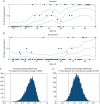The Ageing Brain: Age-dependent changes in the electroencephalogram during propofol and sevoflurane general anaesthesia
- PMID: 26174300
- PMCID: PMC4501918
- DOI: 10.1093/bja/aev213
The Ageing Brain: Age-dependent changes in the electroencephalogram during propofol and sevoflurane general anaesthesia
Abstract
Background: Anaesthetic drugs act at sites within the brain that undergo profound changes during typical ageing. We postulated that anaesthesia-induced brain dynamics observed in the EEG change with age.
Methods: We analysed the EEG in 155 patients aged 18-90 yr who received propofol (n=60) or sevoflurane (n=95) as the primary anaesthetic. The EEG spectrum and coherence were estimated throughout a 2 min period of stable anaesthetic maintenance. Age-related effects were characterized by analysing power and coherence as a function of age using linear regression and by comparing the power spectrum and coherence in young (18- to 38-yr-old) and elderly (70- to 90-yr-old) patients.
Results: Power across all frequency bands decreased significantly with age for both propofol and sevoflurane; elderly patients showed EEG oscillations ∼2- to 3-fold smaller in amplitude than younger adults. The qualitative form of the EEG appeared similar regardless of age, showing prominent alpha (8-12 Hz) and slow (0.1-1 Hz) oscillations. However, alpha band dynamics showed specific age-related changes. In elderly compared with young patients, alpha power decreased more than slow power, and alpha coherence and peak frequency were significantly lower. Older patients were more likely to experience burst suppression.
Conclusions: These profound age-related changes in the EEG are consistent with known neurobiological and neuroanatomical changes that occur during typical ageing. Commercial EEG-based depth-of-anaesthesia indices do not account for age and are therefore likely to be inaccurate in elderly patients. In contrast, monitoring the unprocessed EEG and its spectrogram can account for age and individual patient characteristics.
Keywords: EEG; ageing; brain monitoring; elderly; electroencephalography; propofol; sevoflurane.
© The Author 2015. Published by Oxford University Press on behalf of the British Journal of Anaesthesia. All rights reserved. For Permissions, please email: journals.permissions@oup.com.
Figures





Comment in
-
The ageing brain.Br J Anaesth. 2016 Nov;117(5):672. doi: 10.1093/bja/aew349. Br J Anaesth. 2016. PMID: 27799188 No abstract available.
Similar articles
-
Age-dependency of sevoflurane-induced electroencephalogram dynamics in children.Br J Anaesth. 2015 Jul;115 Suppl 1(Suppl 1):i66-i76. doi: 10.1093/bja/aev114. Br J Anaesth. 2015. PMID: 26174303 Free PMC article.
-
Effects of sevoflurane and propofol on frontal electroencephalogram power and coherence.Anesthesiology. 2014 Nov;121(5):990-8. doi: 10.1097/ALN.0000000000000436. Anesthesiology. 2014. PMID: 25233374 Free PMC article.
-
Ageing delays emergence from general anaesthesia in rats by increasing anaesthetic sensitivity in the brain.Br J Anaesth. 2015 Jul;115 Suppl 1(Suppl 1):i58-i65. doi: 10.1093/bja/aev112. Br J Anaesth. 2015. PMID: 26174302 Free PMC article.
-
Using Electroencephalography (EEG) to Guide Propofol and Sevoflurane Dosing in Pediatric Anesthesia.Anesthesiol Clin. 2020 Sep;38(3):709-725. doi: 10.1016/j.anclin.2020.06.007. Anesthesiol Clin. 2020. PMID: 32792193 Review.
-
The EEG signal: a window on the cortical brain activity.Paediatr Anaesth. 2012 Jun;22(6):539-52. doi: 10.1111/j.1460-9592.2012.03883.x. Paediatr Anaesth. 2012. PMID: 22594406 Review.
Cited by
-
Age-Related EEG Power Reductions Cannot Be Explained by Changes of the Conductivity Distribution in the Head Due to Brain Atrophy.Front Aging Neurosci. 2021 Feb 18;13:632310. doi: 10.3389/fnagi.2021.632310. eCollection 2021. Front Aging Neurosci. 2021. PMID: 33679380 Free PMC article.
-
Potential increased propofol sensitivity in cognitively impaired elderly: a controlled, double-blind study.Front Aging Neurosci. 2024 Jul 9;16:1410181. doi: 10.3389/fnagi.2024.1410181. eCollection 2024. Front Aging Neurosci. 2024. PMID: 39044807 Free PMC article.
-
Desflurane is risk factor for postoperative delirium in older patients' independent from intraoperative burst suppression duration.Front Aging Neurosci. 2023 Feb 1;15:1067268. doi: 10.3389/fnagi.2023.1067268. eCollection 2023. Front Aging Neurosci. 2023. PMID: 36819718 Free PMC article.
-
Cognitive Impairment Is Associated with Absolute Intraoperative Frontal α-Band Power but Not with Baseline α-Band Power: A Pilot Study.Dement Geriatr Cogn Disord. 2019;48(1-2):83-92. doi: 10.1159/000502950. Epub 2019 Oct 2. Dement Geriatr Cogn Disord. 2019. PMID: 31578031 Free PMC article.
-
The Effect of Sevoflurane Anesthesia on the Biomarkers of Neural Injury in the Prefrontal Cortex of Aged Marmosets.Front Aging Neurosci. 2022 Jun 30;14:918640. doi: 10.3389/fnagi.2022.918640. eCollection 2022. Front Aging Neurosci. 2022. PMID: 35847680 Free PMC article.
References
-
- Center for Health Workforce Studies Impact of the Aging Population on the Health Workforce in the United States. Rensselaer, NY: University at Albany, 2006; 6
-
- Martin G, Glass PS, Breslin DS, et al. A study of anesthetic drug utilization in different age groups. J Clin Anesth 2003; 15: 194–200 - PubMed
-
- Sear JW. Implication of aging on anesthetic drugs. Curr Opin Anaesthesiol 2003; 16: 373–8 - PubMed
-
- Monk TG, Weldon BC, Garvan CW, et al. Predictors of cognitive dysfunction after major noncardiac surgery. Anesthesiology 2008; 108: 18–30 - PubMed
Publication types
MeSH terms
Substances
Grants and funding
LinkOut - more resources
Full Text Sources
Other Literature Sources
Medical

